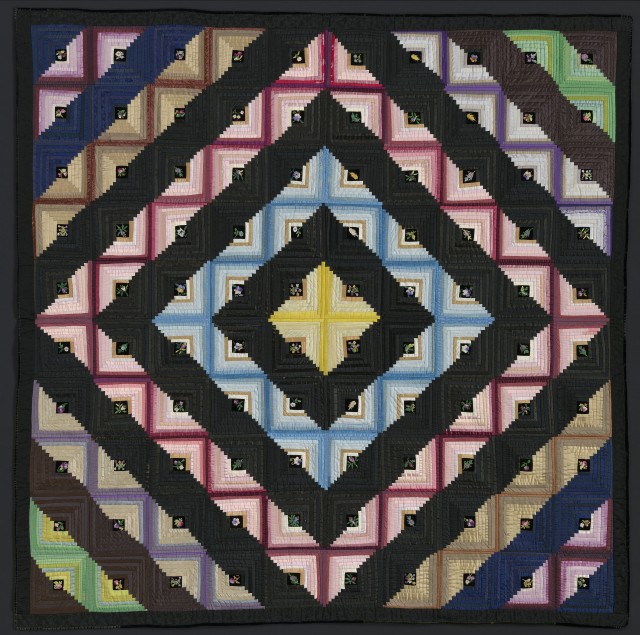Quilts, boring–just how interesting could they be? This uniformed thought almost prevented me from seeing one of the most spectacular and moving art exhibits of my life, an exhibit of American quilts now at the Boston Museum of Fine Arts. Walking in was akin to being blasted by lightening. The show figuratively blew the top of my head off. Color and design, design and color for the pure joy of it. Unburdened by pretentiousness, political ranting, and underlying messages, they succeed as sublime masterworks; only crafted of humble materials and by the humblest of hands. Rumpelstiltskin’s dream realized, the spinning of simple materials into pure gold.
This is a finely curated selection from the collector Gerald Roy, who grew up in Worcester, Mass. He had been a student at the Worcester Art Museum’s school, where he absorbed the color theories of the influential artist and teacher Josef Albers. The quilts cover a period from the early 19th century to the 1940’s. It is hard- at least for me, to pick a favorite. A few quilting aficionados were excitedly pointing out the perfection of the craftsmanship to the consternation of the museum guards. There are wall blasting quilts of saturated color and some with more subtle if not totally quiet, harmonies. I have always felt that color unlike monochromatic work is intuitive. Otherwise how could these women put together designs and color that rival and indeed exceed many contemporary color field and op-art painters without any color theory education? As these quilts were done mostly by rural women of modest means, I doubt if they had heard of Victor Vasarely.

The quilts have a gravitas, a dignity, that belie their unassuming origins–these hand-made, hand stitched masterpieces have the warmth and beauty lacking in much of today’s machine-age and digital art. They make Frank Stella’s thinly painted canvasses look sterile and shallow. Indeed the sophistication of color and design put to shame the museum’s op-art pictures (including a Bridget Riley) placed next to some of the quilts. They are diminished next to work so honest, so exuberant, so unabashed and so joyful. This show has to be seen in person if at all possible, the pictures do not do it justice. One exquisite quilt was done in 1879, by an 81 year old woman for her daughter. If that was not art what is?
The Boston Globe is calling it “The Best Show in New England.” Looking at the recent New York Times art section, I would say it might be the best show in the Northeast–if not the country.
If anything, this showed me what the heart of art is–it is not in the million dollar Damien Hirst paydays, nor the blockbuster Gagosian Gallery shows, nor in the adulation and reviews in the New York Times. This is art in its purest and happiest form.
For any of you lucky enough to be able to see this show–run. Artists and artisans if ever there was an inspiration to continue work that may seem insignificant and unsung, that brings you joy–this is it.
As one of the quilt-makers explained: “I make my quilts as fast as I can so my children won’t freeze and as beautiful as I can so my heart won’t break.”
Information here: http://www.mfa.org/exhibitions/quilts-and-color

Top image: Double Wedding Ring quilt, American, about 1940. Pieced cotton plain weave top, cotton plain weave back and binding; quilted. Pilgrim/Roy Collection.
